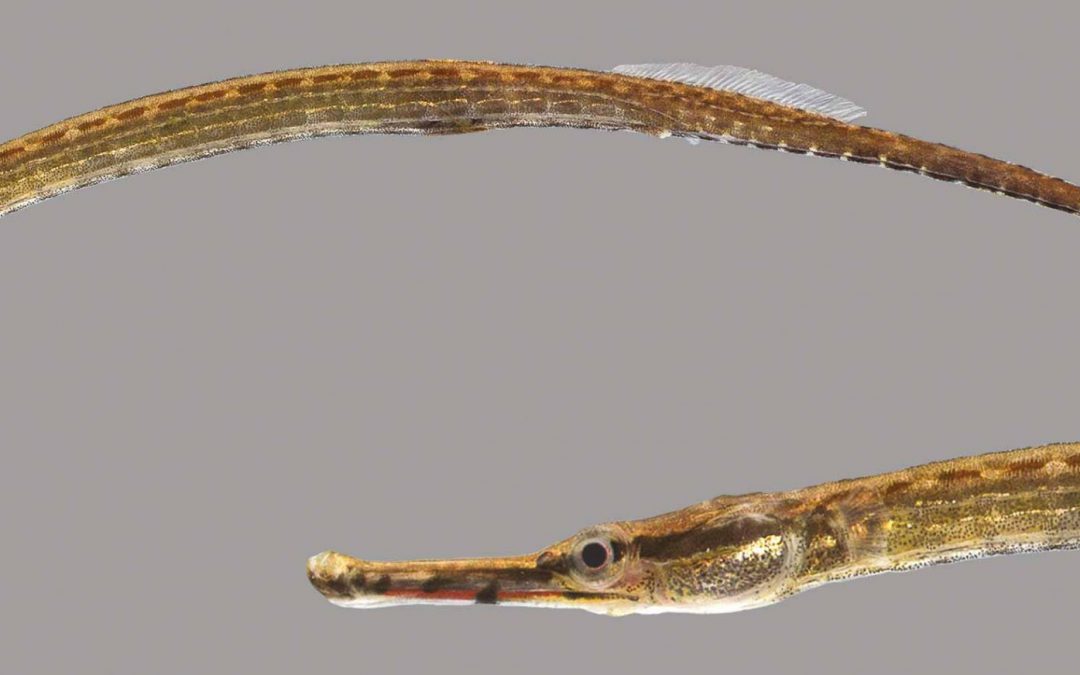
by Rick O'Connor | Feb 18, 2022
I recently posted an article about the seahorses of the Florida panhandle. It would be remiss of me if I did not include their close cousins the pipefish. Where seahorses are well known but hard to find, pipefish are easy to find but not well known.

The seahorse-like pipefish.
Photo: University of Florida
Pipefish are in the same family as seahorses, Syngnathidae, and are basically elongated seahorses. Pulling seine nets in local grassbeds we often catch them. Students always ask what they are. “Are these needlefish?” is a frequent question. I reply “no, they are pipefish”. Which then comes “pikefish?”. To which I reply “No, PIPEfish… like P-I-P-E… – they are basically elongated seahorses”. And then there is always – “coool”. To which I reply “yes… very cool”.
Pipefish have the same body armor, body rings, and long tube snout of the seahorse. However, they lack the curled prehensile tail for a more elongated body, looking more a grass blade than their cousins. They actually have a caudal fin (the fin most call “fish tail”). Most range between 3-6 inches long but the chain pipefish can reach a length of 10 inches, this is the “big boy” of the group. Like seahorses, they hide in the grass using their tube-shaped mouths to suck in small planktonic food. Like the seahorses, the males’ possess a brood pouch to carry the fertilized eggs and give live birth (ovoviviparous).
The pipefish can quickly be divided into two groups – those with long snouts, and those with short – and this can be easily seen when captured in a net. After that identification gets a bit tricky, you have to count rays in the fins or rings on the body. It is sufficed to say, “it’s a pipefish” and leave it at that.
Those with long snouts include the Opossum, Chain, Dusky, and Sargassum pipefish.
The Opossum Pipefish (Microphis brachyurus) is about 3 inches long and was not reported from the northwestern Gulf of Mexico according to Hoese and Moore1. In the eastern Gulf, our way, it is considered rare but has been found in salt marshes, seagrasses, and in Sargassum mats drifting in from the Gulf. The Florida Museum of Natural History list this fish as a “marine invader”2. In 1991 NOAA listed it as a species of concern due to its decline across the region3. There are reports of this pipefish entering freshwater creeks within our estuaries.
The Chain Pipefish (Syngnathus louisianae) has a very long snout and is the “big boy” of the group reaching 10 inches in length. It is quite common along the panhandle and has one of the larger ranges of this group, found all along the Atlantic coast, throughout the Gulf of Mexico and in the Caribbean.
The Dusky Pipefish (Syngnathus floridae) is a long-snout, large pipefish reaching a length of eight inches. It prefers higher salinity than many pipefish and is found throughout the Gulf of Mexico and along the Atlantic seaboard often offshore.
The Sargassum Pipefish (Syngnathus pelagicus). This is a good scientific name for this fish (pelagicus) for it lives on the large mats of Sargassum weed that drifts across the oceans. Because of this it has a worldwide distribution. This longnose pipefish reaches the typical length of six inches. It lives as many other pipefish do hiding in the grass snapping up food when it comes close enough but it’s habitat is often drifting offshore and inshore sightings of this species are rare.
There are three species of “short-snout” pipefish.
The Fringed Pipefish (Anarchopterus crinigerus) is a smaller pipefish reaching only three inches. It seems to be absent in the western Gulf but is found along the Florida panhandle, the Gulf coast of peninsula Florida, and through the Caribbean to Brazil.
The Northern Pipefish (Syngnathus fuscus) reaches a length of six inches. It is very common along the Atlantic seaboard but Hoese and Moore1 report only four specimens from the Gulf of Mexico. This one would be considered very rare, and an expert should identify it if one thinks they have it.
The Gulf Pipefish (Syngnathus scovelli) is one of the more common pipefish collected in our waters. It is a short-snout species reaching the typical six inches but has these distinct bluish-gray bars that run vertically along the sides. It is found throughout the Gulf of Mexico and even into some freshwater habitats. The Florida Museum of Natural History also list this species as a marine invader4.
I am not sure how much seining you do along our waterways, but if you do any within the grassbeds you are sure to find one of these unique and interesting fish.
References
1 Hoese, H.D., Moore, R.H. 1977. Fishes of the Gulf of Mexico. Texas A&M Press, College Station TX. Pp. 327.
2 Opossum pipefish. Discover Fishes. Florida Museum of Natural History. https://www.floridamuseum.ufl.edu/discover-fish/florida-fishes-gallery/opossum-pipefish/.
3 Opossum Pipefish. Species of Concern. National Oceanic and Atmospheric Administration, National Marine Fisheries Service. https://www.nrc.gov/docs/ML1224/ML12240A312.pdf.
4 Gulf Pipefish. Discover Fishes. Florida Museum of Natural History. https://www.floridamuseum.ufl.edu/discover-fish/florida-fishes-gallery/gulf-pipefish/.
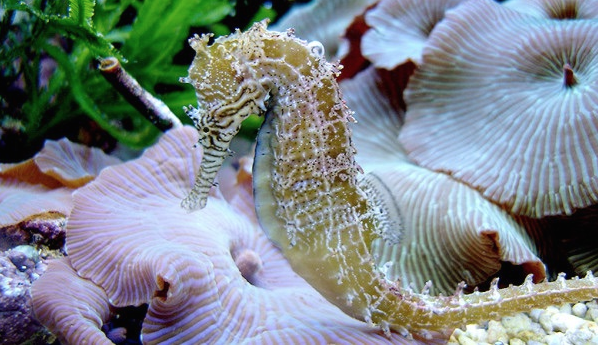
by Rick O'Connor | Feb 3, 2022
Seahorses are one of the coolest creatures on this planet – period. I mean who doesn’t like seahorses? People state “I love snakes”, “I hate snakes”, “I love sharks”, “I hate sharks”. But no one says, “I hate seahorses”. They are sort of in the same boat with sea turtles, everyone loves sea turtles. They are an icon of the sea, logos for beach products and coastal HOAs, underwater cartoons and tourist development boards, diving clubs and local restaurants. But have you ever seen one? I mean beyond seeing one at a local aquarium or such, have you ever found one while snorkeling on one of our beaches?
Most would say no.
I have lived in the panhandle all my life and have spent much of it in the water, and I can count on both hands the number of times I have encountered a seahorse while at the beach. Most encounters have been while seining. I cannot count on both hands how many times I have pulled a seine net here but very few of them did a seahorse encounter occur. When they did, it was over grassbeds. In each encounter the animal was lying in the grass not wriggling like the other fish, just lying there. It would be very easy to miss them discarding it as “grass”. It makes you wonder how many times I captured one and did not know it. When we did find one it was VERY exciting. My students would often scream “I had NO idea they lived here!”.
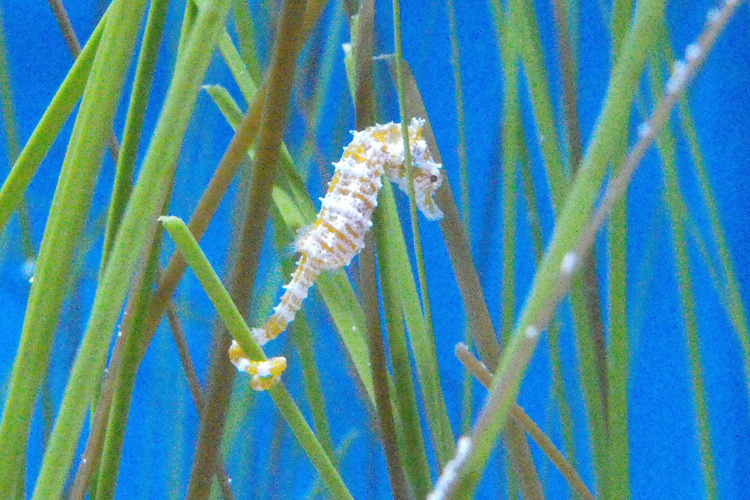
The seahorse Photo: NOAA
However, if you tried searching for them while snorkeling, which I have, the encounter rate is zero. But this makes sense. These animals are so well camouflaged in the grass it would be a miracle to find one just hanging there. This is by necessity really. If you have ever watched a seahorse in an aquarium they are not very “fleet of foot”. Escaping a predator by dashing away is not one of their finer skills. No, they must blend in and remain motionless if trouble, like a snorkeler, comes by.
But I have seen one while diving. It was a night dive near the Bob Sikes Bridge on Pensacola Beach about 40 years ago. We were exploring when my light swung over to see this large seahorse extended from a pipe that was coming out of some debris on the bottom. I was jubilated and screamed, as best you can while using SCUBA, for my partners to come check this out. We were all amazed and my interest in these animals increased.
When I attended Dauphin Island Sea Lab (DISL) as an undergraduate student, like many in the 1970s, I thought I would get involved with sharks, but I quickly developed a love for estuaries and my interest in seahorses returned. I made a visit to the library there and found very little in the literature, at that time, which piqued my interest even more. My senior year we had to complete a project where we had to collect, and correctly identify, 80 species of fish to pass the class. I asked the crew of the research vessel at DISL if they had ever found seahorses. They responded yes and took me to what they called their “seahorse spot”. We caught some. It was very cool. And yes… seahorses do exist here in the wild.
But what is this amazing animal?
What do I mean by this? As a marine science instructor, I would give my students what are called a lab practical’s. Assorted marine organisms would be scattered around the room and the students had to give their common name, phylum name, class name, and answer some natural history question I would ask. Snails are mollusk, mackerel are fish, jellyfish are cnidarians, and then they would come to the seahorse. Seahorses were… well… seahorses! What the heck are they?
Many of you may know they are fish. But over the years of teaching marine science, I found that many students were not sure of that. The definition of a fish is an animal with a backbone that possesses a scaly body, paired fins (usually), and gills. Seahorses have all that. There is a backbone no doubt. The scales are not as obvious because they are actually fused together in a sort of armor. The paired fins and gills are there. Yep… they are fish, but a fish (horse) of a different color.

This seahorse is a species from Indonesia.
Photo: California Sea Grant.
First, they are one of about 13 families of fish in the Gulf of Mexico that lack ventral fins, those on the belly side of their bodies. Second, they lack a caudal fin (the fish tail) and have a more prehensile tail for grabbing objects. Third, they swim vertically instead of horizontally as most fish do. Again, there is nothing about their body design that says “speed”.
Another thing I find fascinating about these animals is their global distribution. You might recall that the initial focus of this series on Florida panhandle vertebrates was the biogeography of these creatures. Seahorses are found all over the world. There are over 350 species of them. But the interesting question is: how would a seahorse living in the northern Gulf of Mexico reach Melbourne Australia? It makes sense that being so far apart there would be such differences in looks and genetics that they would be classified as different species, but how did an animal like a seahorse disperse across a large ocean like the Pacific?
Honestly, I can say the same for ghost crabs, which I found on the beaches of Hawaii. How did they get there? But that is another story.
My best guess was the dispersal occurred at a time when the two continents were closer together. The Pangea days, or some time close to that period. And as the continents “drifted” the seahorses remained close to their shorelines and moved apart. They may have been able to “island hop” across coral reefs to other Indonesian Islands, but those here in the United States were long lost relatives that changed in their appearance and lifestyles due to the large separation from others. That is my two cents anyway.
Hoese and Moore1 list two species of seahorses found here in the northern Gulf of Mexico. The Lined Seahorse and the Dwarf Seahorse.
The Lined Seahorse (Hippocampus erectus) is the larger of the two, reaching an average length of five inches. This is the one I found near the Bob Sikes Bridge all those years ago. Like all seahorses they are well adapted to life in debris where they can grab on to something with their prehensile tail and feed on small zooplankton using their vacuum like tube snout. Like all seahorses, the males have a brood pouch that holds the fertilized eggs producing live birth – another “live bearer”. They are usually dark in color, but gold individuals have been reported. Some have filamentous threads on their bodies making them look even more like plants. Their biogeographic distribution is amazing. They are found from Nova Scotia, throughout the tropics, all the way to Argentina. This suggests few biogeographic barriers, other than substrate to hide in.
The Dwarf Seahorse (Hippocampus zosterae) – also known as the pygmy seahorse – is much smaller, with a mean length of 1.5 inches. That would qualify as “dwarf” or “pygmy”. How would you ever find these? Other than size, the difference between these two are the number of rays (soft spines) in their fins. They can be counted, but its not fun, especially with a 1.5” seahorse. This guy prefers high salinity, actually, I have found that most seahorses do. This one is more tropical in distribution.
There is a third Florida species, the long snout seahorse (Hippocampus redi) that is found on the Atlantic coast, but not in the Gulf.
The strange thing about the seahorses in Florida, has been the declining encounters over the last few decades. For a creature that seems to have few barriers, they have found trouble somewhere. Maybe the loss of habitat, maybe a population crash due to the common practice years ago of capture and drying out for tourists to buy. It could be a change in environmental conditions such as salinity in the Pensacola Bay area. I am not sure. The more I write this article, the more my interest in this fish returns. As many researchers and wildlife managers have mentioned, this is an animal who has “fallen through the cracks”. People notice the changes in sea turtle and manatee encounters, but not seahorses. Maybe it is time we pay more attention to them and see how they are doing. I for one would hate to see the decline of this creature here in the panhandle.
Reference
Hoese, H.D., Moore, R.H. 1977. Fishes of the Gulf of Mexico; Texas, Louisiana, and Adjacent Waters. Texas A&M Press, College Station, TX. Pp. 327.

by Rick O'Connor | Feb 3, 2022
Based on our seine surveys along the beaches of most estuaries in the Florida panhandle, this is one of the most abundant fish in our bays. No matter the time of year, or the location, estuarine seining usually includes numerous individuals of this group. It is very apparent the importance they play in the food web of our local bays.

The silverside, or “glass” minnow.
Photo: U.S. Geological Survey
Those visiting and recreating in our waters probably are not aware of the numerous individuals of this fish schooling all around them. They are almost transparent and are often called “glass minnows” because of this. So, you do not really see them – even if you are snorkeling. But take a small hand net or a seine net and you will quickly discover they are there – and a lot of them.
They are small three-inch fish that are long, and tube shaped with forked (lunate) tails. Their bodies have a slight yellow-green appearance on the dorsal side, but much is a whiteish in color or transparent all together. They do have a broad silver stripe that runs laterally along their body and is where they get their common name “silversides”. Anchovies also have this “silverside” and are found in the same locations but differ from the silversides in that they have a more “shark looking snout” and only one dorsal fin, compared to the two dorsal fins found on the silversides.
It is apparent this whiteish, transparent color and silver stripe are effective in avoiding predation. Again, you and I do not see them while we are snorkeling. But is also apparent that many are consumed due to the large number you find in their schools. I have found from my seining surveys this fish is often collected on days when no other species are. The heat of summer, the cool of winter, during and after storms, high humidity, it does not matter – I always captured them. I have captured them over sandy beaches, over seagrasses, near jetties, and in the muck and mire of salt marshes. They are literally everywhere. I also capture them more frequently than I do anchovies, suggesting their importance to the health of the estuarine food web. It is one of the first fish my students learned to identify because of how frequently we caught them.
In the northern Gulf, there are two species found in local estuaries – the rough silverside and the tidewater silverside. Hoese and Moore1 do report a third species similar to the tidewater silverside that is more tolerant of saltwater.
The Rough Silverside (Membras martinica) is called so because their body scales are serrated and are “rough to the touch”. This is when you slide your fingers from the back towards the head, your fingers will feel the serrations and it is rough to the touch.
The Tidewater Silverside (Menidia beryllina) is smooth to the touch because their scales lack serrations. Other than that, these two fish look very similar. Tidewater silversides seem to be restricted to the shorelines and do not venture to the extended grassbeds off the beach. The third species mentioned M. peninsulae, is reported to prefer salinities at and above 19 ppt, where the tidewater prefers lower salinities. There is little else mentioned to distinguish these two, but I have seen both names reported in the scientific literature from researchers sampling our bay.
Both species of silversides have a large biogeographic distribution. Ranging from the colder waters of New York, all along the eastern seaboard, and the entire Gulf of Mexico.
You may not see them often, but know they are an important part of the estuarine ecology.
Reference
Hoese, H.D., Moore, R. H. 1977. Fishes of the Gulf of Mexico; Texas, Louisiana, and Adjacent Waters. Texas A&M Press, College Station TX. Pp. 327.
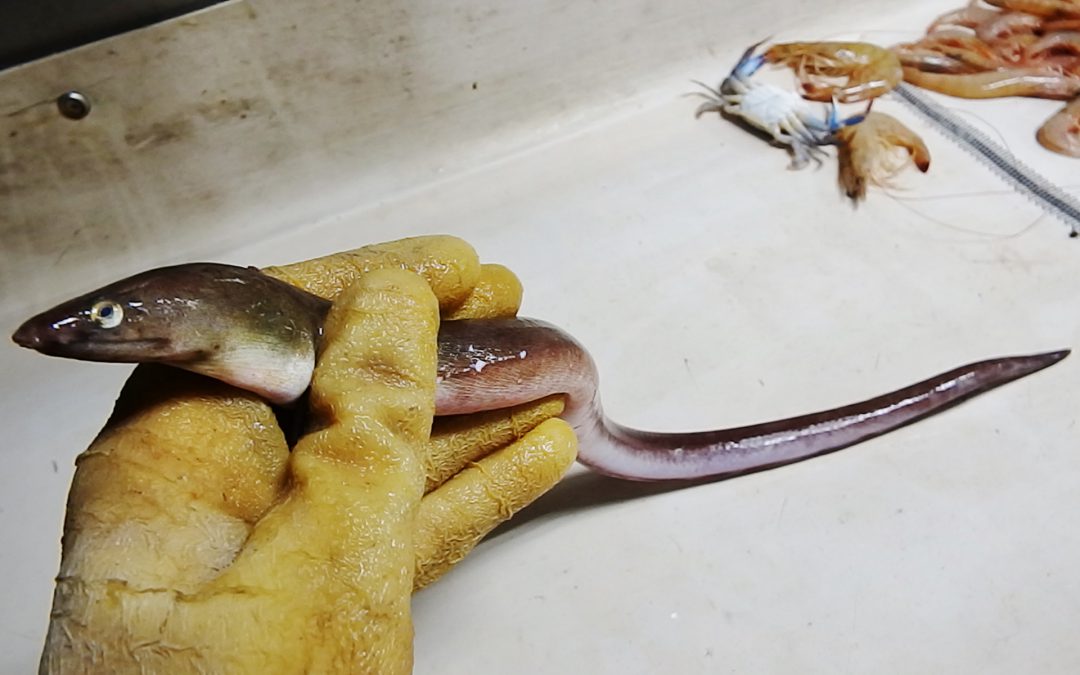
by Rick O'Connor | Sep 2, 2021
Eels… when that name comes up most think of either the vicious moray eels or the famous electric eel. Moray eels do exist in the Florida panhandle, and we will talk about them. Electric eels do not, they are found in the Amazon River system. That said, we do have eels here – quite a few. There are at least 18 species found in six different families. Most are 2-3 feet in length, though the Banded Shrimp Eel (Ophichthus) can reach six feet. About half of them are found offshore on the middle and outer shelves, the other half can be found in the inner shelf and estuaries, a few species swim into freshwater. Shrimpers often catch them when trawling and occasionally anglers will catch them with rod and reel.
Eels superficially resemble snakes and sometimes are confused with them. I have been told more than once that we do have sea snakes here. We do not. What people are finding are one of the 18 species of eels in the area. We do have snakes swimming across our estuaries, but we do not have sea snakes.
Eels differ from snakes primarily in that they, being fish, possess gills – not lungs. Most eels do have sharp teeth, the morays are famous for theirs, but no eels are venomous – so no worries there. Most of our eels have very small scales or are completely scaleless and are often very slimy and difficult to handle. They have been used as bait and one species, the American eel (Anguilla rostrata), has been used for food.
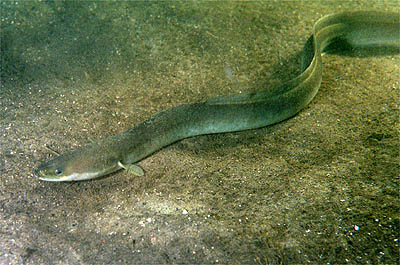
The Anguilla eel, also known as the “American” and “European” eel.
Photo: Wikipedia.
The American eel has an interesting life history. They spawn in the Sargasso Sea, an area in the middle of the Atlantic Ocean. Their developing leptocephalus larva are thin, flat, and transparent in the water. They drift with the ocean currents into the Gulf of Mexico and eventually into our estuaries. I have found them along the shores of Project Greenshores (in Pensacola Bay) during certain parts of the year. From here they work their ways into our local rivers where people encounter the large adults. I have found them living in submerged caves near Marianna and many locals have found them at the bottom of our rivers. When time to breed, the adults will leave and head back to the open Atlantic to begin the cycle again. An amazing trip.
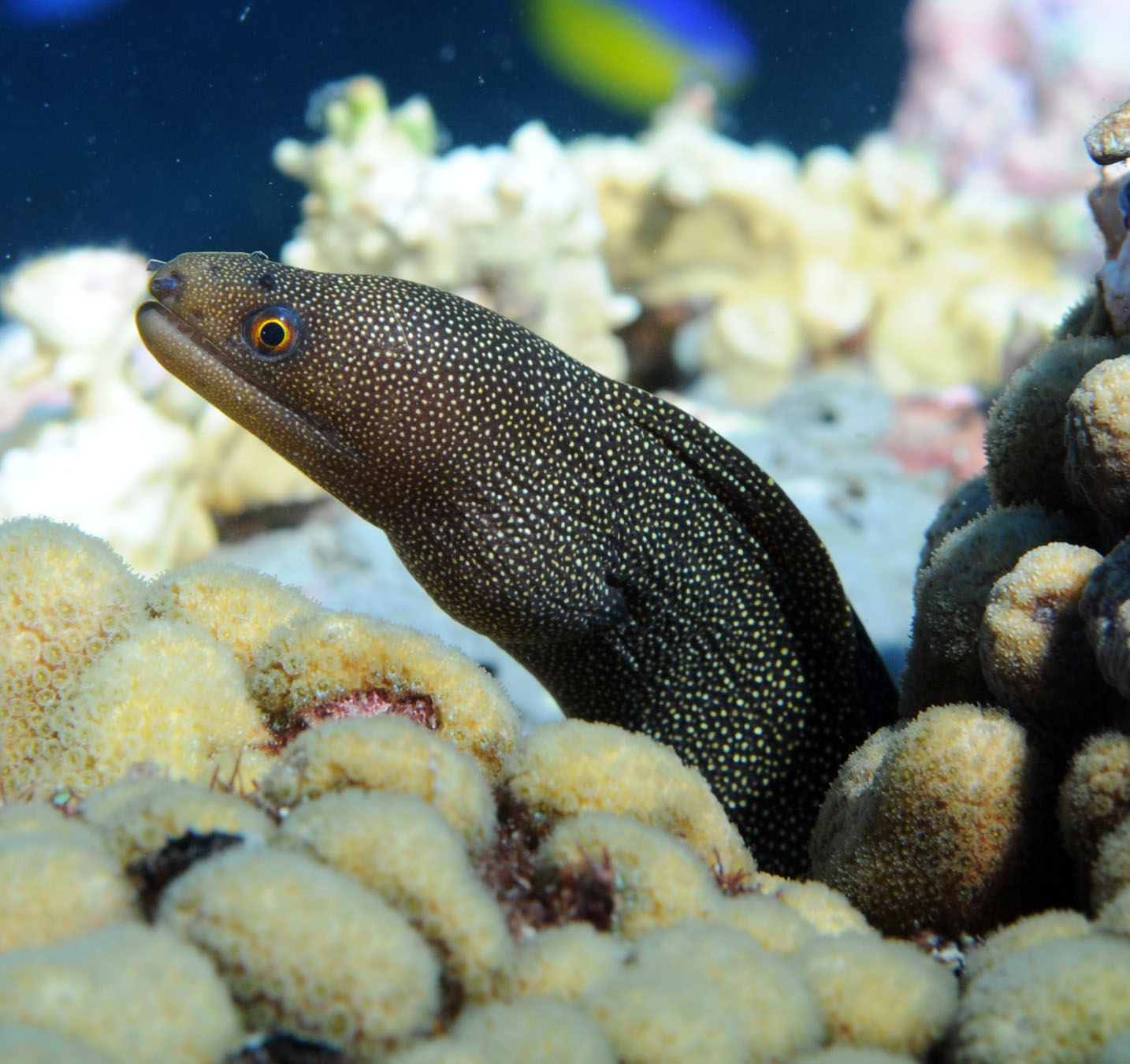
Moray eel.
Photo: NOAA
Moray eels are famous for the nasty attitudes and vicious bites. They are more tropical and associated with offshore reefs, though the ocellated moray (Gymnothorax ocellatus) is often caught in shrimp trawls. They live in the crevices of the reef ambushing prey. Some, like the green moray, can get quite large – over six feet. Like all eels, they have very powerful muscles and sharp teeth.
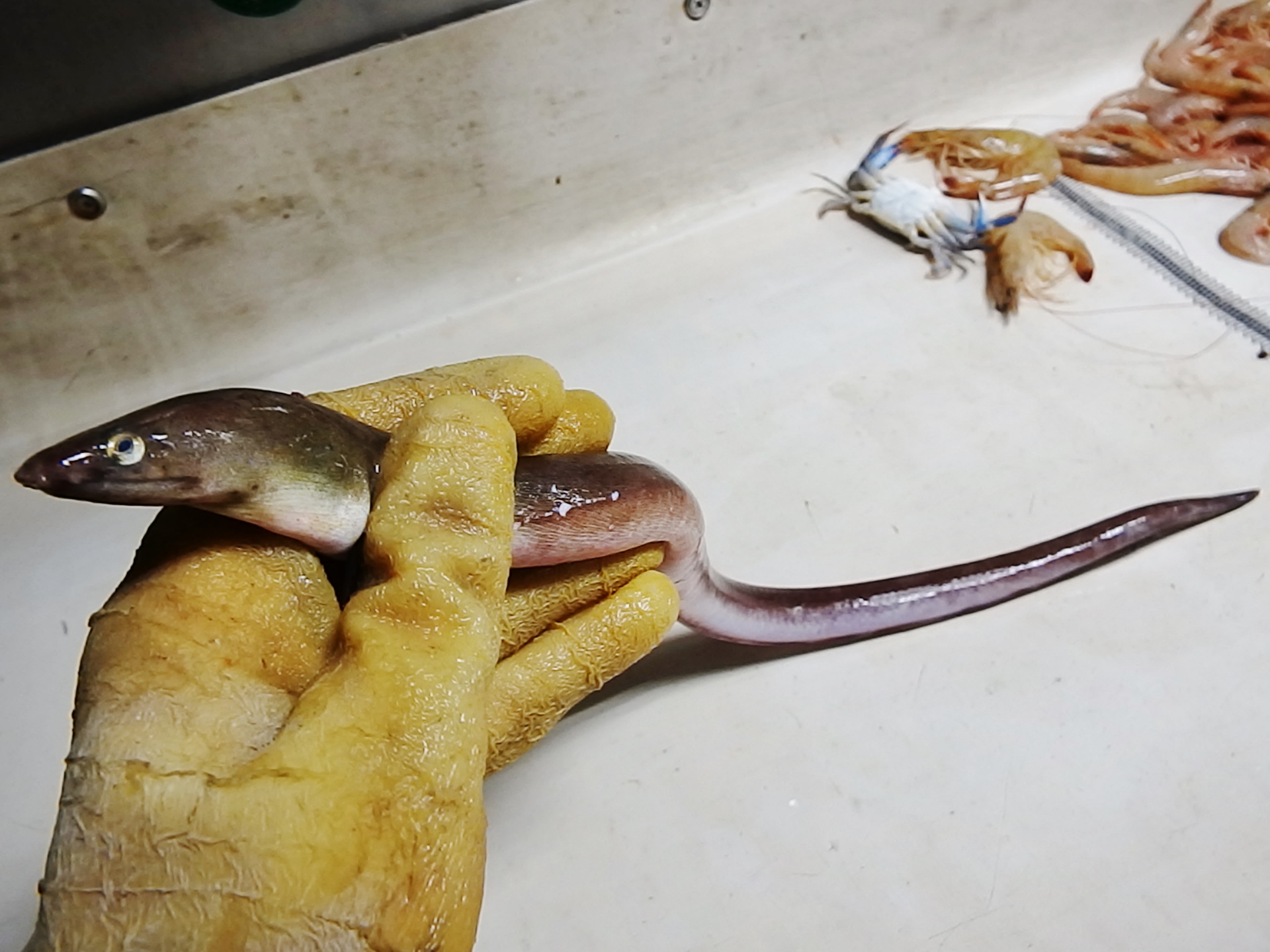
The shrimp eel is common on our inner and middle continental shelf.
Photo: NOAA
Conger eels are very common despite few people ever seeing them. There are six species and they frequent the middle continental shelf, so are rare in estuaries.
There are eight species of snake, or worm, eels. These are more common on the inner shelf and the coastal estuaries. Many prefer muddy bottoms where they bury tail first to ambush prey swimming by.
The majority of these marine eels have a large geographic distribution. Their larva can be carried great distances in the currents and their need for sandy or muddy bottoms can be met just about anywhere. They appear to have few barriers keeping them from colonizing much of the Gulf and surrounding waters. Most fall into the category we call “Carolina Fish”. Meaning their distribution occurs from the Carolinas, throughout the Gulf of Mexico, south to Brazil. There are a few species that can tolerate the lower salinities of the estuaries and one, the Anguilla eel, that can even venture into freshwater.
There are few species restricted to the tropical reefs, such as the morays. But morays are found on our smaller middle shelf and artificial reefs in the northern Gulf. Though found in parts of the Atlantic Ocean, Hoese and Moore1 reported one species of conger eel, Uroconger syringus, as only occurring near south Texas in the Gulf of Mexico. What barriers keep it from colonizing other Gulf habitats is unknown.
Eels are true fish that we rarely encounter. Encounters are usually startling but exciting at the same time. They are pretty amazing fish.
Reference
Hoese, H.D., R.H. Moore. 1977. Fishes of the Gulf of Mexico; Texas, Louisiana, and Adjacent Waters. Texas A&M University Press, College Station TX. Pp. 327.
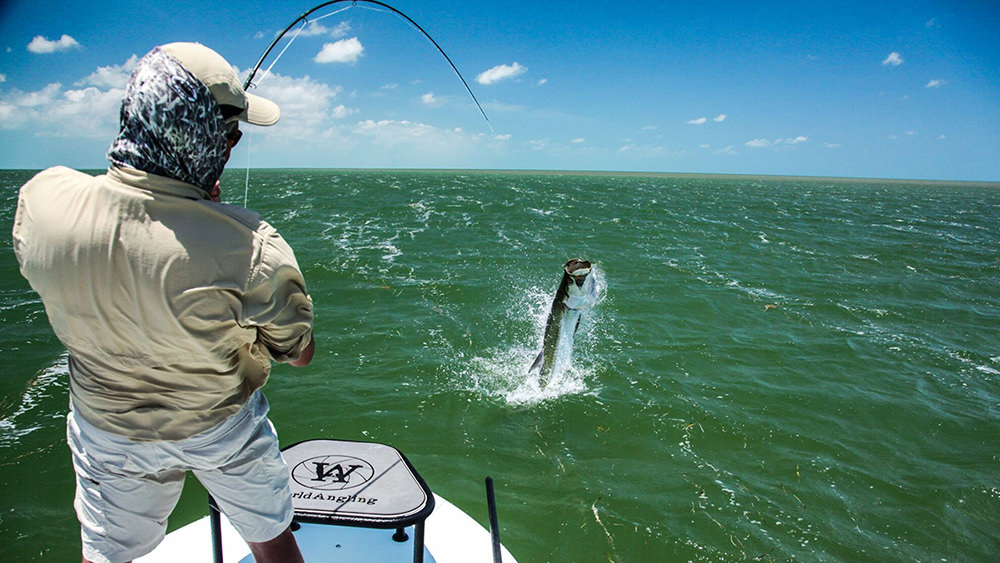
by Rick O'Connor | Aug 18, 2021
This is a famous fish. If you look back at the old tourism magazines of the early 20th century you will see a lot about tarpon fishing in Florida. As a matter of fact, some say that tarpon fishing was the beginning of the tourism industry in the state. Also known as “silver kings”, they put up a tremendous fight which anglers love, particularly on lighter tackle. It is a sport fish, not sought for food, so catch and release has been the rule for years. But those who seek them will tell you it is worth the fight even if you must release it.

Tarpon have been a popular fishing target for decades.
Photo: NOAA
Tarpon (Megalops atlantica) are large bodied, large scaled fish, with a deep blue back and silver sides. They are a large fish, reaching over 8 feet in length and up to 350 pounds. They tend to travel in schools and are often associated with other fish, such as snook2.
It has always been thought of as a “south Florida fish”. As mentioned, down there it is a popular fishing target for tourist and residents alike. Many charter captains specialize in catching the fish and they have been featured in fishing programs. But you do not hear about such things in the Florida panhandle. Hoese and Moore1, as well as the Florida Museum of Natural History2 both indicate that they are in fact in the Florida panhandle. As a matter of fact, this fish has few barriers and has the distribution of the classic “Carolina fish” group. That includes the entire eastern seaboard of the United States, the entire Gulf of Mexico, and the Caribbean1. The Florida Museum of Natural History indicates they are found on the opposite shores of the Atlantic Ocean and may have made their way through the Panama Canal to the Pacific shores of the canal. Within this range they are known to enter freshwater rivers. They seem to have few biogeographic barriers.
I grew up in the panhandle and remember hearing about them swimming in our area when I was younger. Fishermen said they would throw all sorts of bait at them. Artificial lures, live bait, cut bait, you name it – they tossed it… the tarpon never would take it. Catching one here was almost impossible. The flats fishing charter trips for tarpon in south Florida would not happen here. I remember once diving in Pensacola Bay near Ft. Pickens. We were looking for an old Volkswagen beetle that had been sunk years ago when at one point the water became very dark – almost like storm clouds had rolled in. When my buddy and I both looked up we saw a school of very large fish swimming above us. We were not sure what they were at first but as we slowly ascended, we realized they were tarpon. It was pretty amazing.
An interesting side note here. In 2020 tarpon were once again seen swimming around the Pensacola area but this time they WERE taking bait. There were several reports of tarpon caught off the Pensacola Fishing Pier and inside the bay. Why change over all this time? I am not sure.

The ladyfish (or skipjack) is the smaller cousin of the tarpon, but puts up a good fight as well.
Photo: University of Southern Mississippi
Tarpon belong to the family Elopidae which also includes another local fish known as the “ladyfish” or “skipjack” (Elops saurus). This is a much smaller fish reaching about 3 feet (and that would be a large ladyfish). The scales of this family member are much smaller, but the fight on hook and line is just as large. The characteristic that places these two fish into the same family (and these are the only two in this family) is the hard bony gular plate found between the right and left side of the lower jaw (in the “throat” area).
Like tarpon, it is not prized as a food fish but more of a game fish. It has the classic wide distribution of the “Carolina fish group” – the eastern seaboard of the United States, the Gulf of Mexico, down to Brazil. Like the tarpon, it is found in brackish conditions but is not mentioned in freshwater. Again, few biogeographic barriers for this fish.
Both members of this family provide anglers young and old with a lot of enjoyment.
1 Hoese, H.D., R.H. Moore. 1977. Fishes of the Gulf of Mexico; Texas, Louisiana, and Adjacent Waters. Texas A&M Press, College Station TX. Pp. 327.
2 Discover Fishes. Tarpon. Florida Museum of Natural History. https://www.floridamuseum.ufl.edu/discover-fish/species-profiles/megalops-atlanticus/.
3 Discover Fishes. Ladyfish. Florida Museum of Natural History. https://www.floridamuseum.ufl.edu/discover-fish/species-profiles/elops-saurus/.
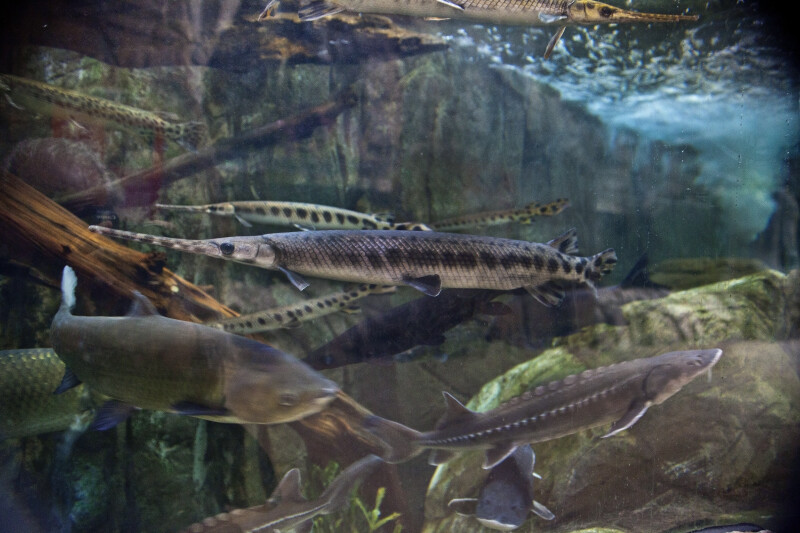
by Rick O'Connor | Aug 8, 2021
Like the ancient sturgeon, this is one strange prehistoric looking group of fish. I’ll say group of fish because there is more than one kind. For many, all gars are alligator gars. There is an alligator gar but there are others. Actually, the longnose gar may be seen more often than the alligator gar, but many do not know there is more than one kind.
Gars are freshwater fish, but several species have a high tolerance for saltwater. The alligator gar (Artactosteus spatula) has been reported from the Gulf of Mexico1. They are elongated, slow moving fish with extended snouts full of sharp teeth – very intimidating to look at. But swimming with gars in springs and rivers, I have found them to be oblivious to me. Snag one in a net however, and they will turn quickly and could do serious harm. While fishing my grandson had one come after his bait once and that was pretty exciting, but it is rare to catch them on hook and line. Many who fish for them do so with bow and arrow. Their skin is covered with tough ganoid scales. You really can’t scale them; you have to skin them.
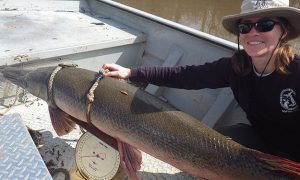
Alligator Gar from the Escambia River.
Photo: North Escambia.com
In the book Fishes of the Gulf of Mexico, by Hoese and Moore, they list four species of gar in the northern Gulf. As the name suggests, the longnose gar (Lepisosteus osseus) has a long slender snout and has spots on the body. It is the one most often seen by people visiting our springs, rivers, and the one most often seen in our estuaries. It can reach a length of five feet3.
The famous alligator gar (Artactosteus spatula) has a shorter snout and spots are usually lacking. If they do have them, the are usually on the fins. This is a big boy – reaching lengths of nine feet and up to 100 pounds2. They are common in coastal estuaries and even the Gulf, though not encountered very often.
The spotted gar (L. oculatus) also has a short snout but has spots all over its body. It prefers the rivers and will enter estuaries only where the salinities are low. It is smaller at four feet4.

Spotted Gar.
Photo: University of Florida
The last panhandle gar is the shortnose gar (L. platostomus). This species too prefers rivers and may enter low salinity bays. It has a short snout and lacks spots.
There is a Florida gar (L. platyrhincus) not found in the panhandle but exists along the central and south Florida gulf coast. It seems to have replaced the spotted gar in this location5.
The biogeography of this group of fish is interesting in that it is an ancient like the sturgeon, it existed during a time period when much of Florida would have been underwater. The general range of gars is the entire eastern United States. They prefer slow moving rivers, or backwaters of faster rivers, and are common in springs. As mentioned, a few species will venture into saltwater and can be found around the Gulf of Mexico. But with several species there has obviously been some speciation over time.

The common longnose gar.
Photo: University of South Florida.
The longnose gars have one of the widest distributions within the group. They are found in most river systems across the eastern United States and all of Florida. It seems to have few barriers including saltwater.
Alligator gars have a similar distribution but seem to be restricted from the peninsula part of Florida. The Florida rivers where they are found are all in the panhandle and are all alluvial rivers – muddy and not tannic like the Suwannee. This could be due to required food that prefer alluvial rivers, pH (pH is lower in the tannic rivers), or something else. Though they did not disperse into central and south Florida, they did extend their range westward down into Mexico. And, as mentioned, have been reported in the open Gulf of Mexico.
Spotted gars follow a similar distribution to the alligator gar. Much of the Mississippi River basin, Florida panhandle, and west to Texas – but they are not found in peninsular Florida. Pre-dating the emergence of peninsular Florida from the sea, there was some barrier that prevented them from dispersing south when the landmass did appear.
A different species appeared in peninsular Florida along with the longnose gar – the Florida gar. It is found in central and south Florida and has dispersed a little north along the Atlantic coast to Georgia.
This is an interesting group of ancient fish. Some are commercially harvested and have suffered from human alterations of river systems. They are amazing to see.
1 Hoese, H.D., R.H. Moore. 1977. Fishes of the Gulf of Mexico; Texas, Louisiana, and Adjacent Waters. Texas A&M Press, College Station TX. Pp. 327.
2 Discover Fishes. Florida Museum of Natural History. Alligator Gar. https://www.floridamuseum.ufl.edu/discover-fish/florida-fishes-gallery/alligator-gar/.
3 Discover Fishes. Florida Museum of Natural History. Longnose Gar. https://www.floridamuseum.ufl.edu/discover-fish/florida-fishes-gallery/longnose-gar/.
4 Discover Fishes. Florida Museum of Natural History. Spotted Gar. https://www.floridamuseum.ufl.edu/discover-fish/florida-fishes-gallery/spotted-gar/.
5 Discover Fishes. Florida Museum of Natural History. Florida Gar. https://www.floridamuseum.ufl.edu/discover-fish/florida-fishes-gallery/florida-gar/.















